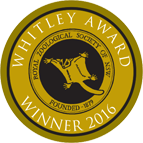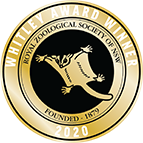Book Review
Neil Fraser
An Atlas of the Birds of NSW and the ACT, Volume 1. Emu to Plains-wanderer
By Richard M. Cooper, Ian A.W. McAllan and Brian R. Curtis, 2014.
New South Wales Bird Atlassers Inc. 720 pp., numerous tables, graphs and maps.
Hardback, A4 format, $135.00, ISBN 978-0-957704-73-2
Have you ever wondered how the hundreds of hours you have spent being bitten by mosquitoes, shivering in freezing winter winds, wading through ankle-deep mud or getting tired and sunburnt while conducting bird surveys contributes to the understanding and conservation of our avifauna? The recently published Atlas of the Birds of NSW and the ACT, Volume 1, (Atlas) answers this question with a comprehensive display of the power of the work of ‘citizen scientists’. The Atlas is a milestone in the literature of the distribution, breeding, migration, historical change and current status of NSW & ACT avifauna. It also covers adjacent waters of the western Tasman Sea and is the first of three volumes to be published by the New South Wales Bird Atlassers (NSWBA). Volume 1 covers 183 species from Emu to Plains-wanderer and represents the contribution of tens of thousands of hours of input from more than 1500 volunteers including field observers, researchers, data analysts, writers, reviewers and cartographers.
The Atlas has a simple and well written introduction that explains the Atlas objectives, how to interpret the contents and summarises the methodology used, data sources, data vetting and processing. The Atlas draws on 5.6 million records obtained from April 1770 to 31 December 2006. About one half of the data used was from NSWBA field work, literature, historical records and reports from the general public. The remaining data was obtained from Ornithological Groups, Tertiary Institutions, The Australian Museum, private records and BirdLife Australia. In the process of assembling the data set, NSWBA digitised a number of historical and private collections of records.
All data was vetted to ensure correct identification and location of species, and to remove duplicated records and bias. The number of species recorded in each 10-minute block is greatest in near-coastal regions, and around major population centres, and decreases progressively to the west. Surprisingly, there are a number of 10-minute land blocks in Central NSW with no observations. Records for pelagic species are much fewer and restricted mainly to near-inshore waters, except where pelagic surveying has been conducted.
Bird watchers will not be surprised to learn that the ten most frequently reported species in NSW & ACT are Australian Magpie, Magpie-lark, Willie Wagtail, Galah, Welcome Swallow, Laughing Kookaburra, Crested Pigeon, Black-faced Cuckoo-shrike, Australian Raven and Superb Fairy-wren.
Factors that affect avian distribution and the impact of key threatening processes for birds are summarised. The proportion of remnant native vegetation in woodland districts in NSW is recorded as varying from 9 to 25%.
The text for each species covers breeding, seasonal movements, historical records and changes in distribution, current status, and is supported by maps, tables and graphs. The text is enhanced by the inclusion of a limited number of excellent photographs. There is a summary of the number of records, reporting blocks and breeding blocks used for each species. Data is presented as maps of Reported Distribution 1971-2006, Reporting Rate (frequency of occurrence during Atlas surveys) and Reported Breeding Distribution. Where sufficient data is available, Historical Distribution Maps for the periods 1770-1970, 1971-1980, 1981-1990 and 1991-2000, or more limited time periods, are presented. The maps are constructed with 30- minute grids showing Reported Distribution and Breeding data points for each of the 10-minute blocks with records. The Reporting Rate maps present data for 30-minute blocks and display four levels of reporting differentiated by symbols
Seasonal Reporting Rates for nine Bioregions are presented for land birds in tables where sufficient data is available. Monthly Breeding, Monthly Reporting Rate and Annual Reporting Rate (1986- 2006) data is presented as histograms. The Reporting Rate data is summarised in a table with the number of records used, the reporting rate trend and the statistical significance of the trend reported as a “p-value”. Analysis is limited to breeding season and changes in reporting rate over time.
The nine Bioregions used in the Atlas were identified by a biogeographic analysis of the NSW Bird Atlas dataset by Julian R.W. Reid, Fenner School of Environment & Society, ANU. This analysis is included in Appendix 2. Bioregions are North Coast, Northern Tablelands and Escarpment, Central & South Coast, Tablelands, Western Slopes, Riverine Plain, Central Peneplain, Mallee & Acacia Woodland, and Arid. The diagnostic species of each region are presented in tables. The Hunter Region occupies the most complex biogeographic area in NSW, located at the convergence of four bioregions: North Coast; Central and South Coast; Northern Tablelands and Escarpment; and Tablelands. This is one reason the Hunter Region supports the largest number of species of any geographic region in NSW & ACT.
I found the text to be clear and concise and the maps, tables and graphs are simple, easy to read and well labelled. The text is fully referenced. Appendix 1 includes a comprehensive list of the historical literature. The manuscript sources used, involving over 1,000 publications and other sources, are listed in References.
Data presented in monthly reporting rates combined with seasonal distribution maps illustrates species migration and is supported by a concise summary of relevant reference sources. At the finest scale, altitudinal migration is documented for some species including White-necked Heron, White-faced Heron, Australian Wood Duck, Australian Hobby, Brown Falcon and Nankeen Kestrel. On a broader scale, seasonal movements between coastal and inland areas in response to annual weather patterns and breeding cycles is well illustrated for many species. For other species that migrate beyond state borders as part of their annual cycle, the lack of distribution maps for adjoining states can be somewhat frustrating, but is well outside the scope of this publication.
The maps showing changes in distribution and graphs showing reporting rate trends over time document the decline of many species, but also significant expansion for others. Species that have extended their distribution include many members of the Family Columbidae, Pacific Baza, Square-tailed Kite, Eastern Osprey, Cattle Egret, Black-necked Stork and Australian Brush-turkey.
For the Hunter Region, the declines of Emu and Bush Stone-curlew are illustrated as are increases for species such as the Wompoo Fruit-Dove, Wandering Whistling-Duck and the Plumed Whistling-Duck. The seasonal reporting rate changes for pelagic species including petrel, shearwater, booby, prion and albatross are well illustrated and documented.
The Atlas data indicate that the annual reporting rate for 45 species is increasing, including 12 species determined as threatened by the NSW Scientific Committee. Most concerning however, is that reporting rates for 67 species are declining at significant levels, including 10 species listed as threatened in NSW. The results also indicate that further monitoring is required to be able to report conclusively on the status of another 33 species. The plight of the Endangered Plains-wanderer is highlighted with distribution now limited to the western Riverina, a rapidly declining annual reporting rate and very few reports since 1994. Some species exhibit U-shaped annual reporting trends. These include the Blue-billed Duck, Great Crested Grebe and the Australasian Shoveler. The reasons for these changes are unclear.
The Atlas is a stand-alone document and does not duplicate information recorded in the Handbook of Australian, New Zealand and Antarctic Birds (HANZAB). While avian distribution and population, movements and breeding dispersion are discussed from referenced sources in HANZAB, there is no quantitative data in these volumes which were published in the early 1990s and which are becoming increasingly out of date. The Atlas also provides further support for the conclusions and recommendations published in the State of Australian Birds Series by Birds Australia in the mid-2000s.
The Atlas presents data in a quantitative format that allows a better understanding of the status and needs of each species, and identifies where conservation management efforts are best concentrated. It also provides a baseline against which future studies, trends and the effectiveness of conservation programmes can be measured.
One of the great strengths of the Atlas is the information provided regarding the patterns of annual movements of species and their change in distribution over time. The establishment of detailed data sets for periods of up to 35 years for most species covers multi-generational time frames and allows assessment of population trends using IUCN listing criteria.
The Atlas will be a great source of data for researchers of the effects of Climate Change. There are a number of species that exhibit changed distribution/range and are now reported more frequently in coastal areas than in the west, and some species that have increasing reports in the south of the state. The Pacific Baza is one species that is cited in the text as an example.
The Atlas is probably not a reference source for the less curious bird enthusiast. It will appeal mainly to more technically minded ornithologists, conservation organisations, wildlife managers, environmental consultants, scientists and government agencies. The data will be invaluable in developing policy, minimising future impact and planning more cost-effective research and conservation programmes. It also provides an early warning system for non-flagship species that will require closer monitoring. It will help identify new Important Bird Areas (IBAs) and provide support for existing IBAs.
The detailed compilation of historical records and other private data sources completed by NSWBA as part of the research for this publication will be a valuable resource for future researchers.
Volume 2 is planned to be published in 2015 and will cover species from the Comb-crested Jacana to the Striated Pardalote. Volume 3 will cover the Eastern Spinebill to the Common Greenfinch, as well as vagrant species, and the birds of the Lord Howe Island group.
Neil Fraser
The Whistler, an occasional publication, Hunter Bird Observers Club
No 8 2014, Pages 51-53









